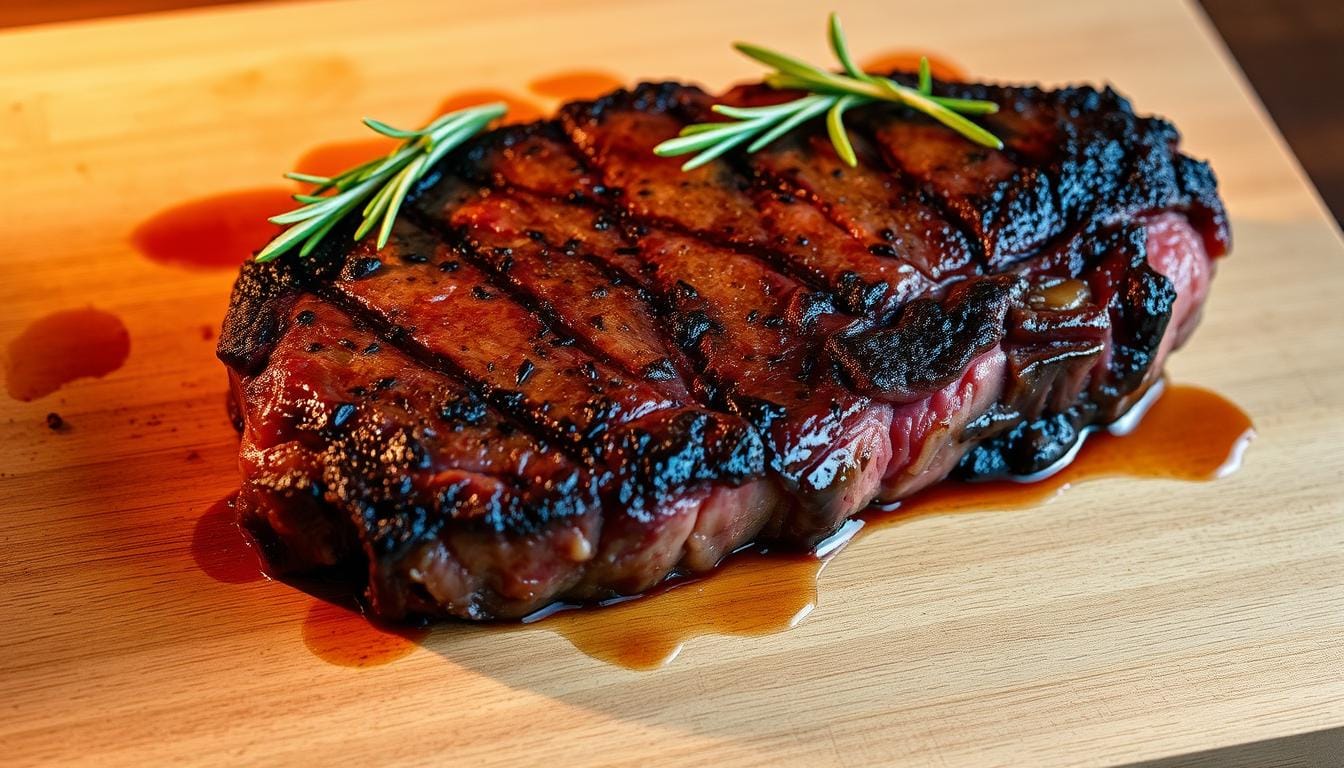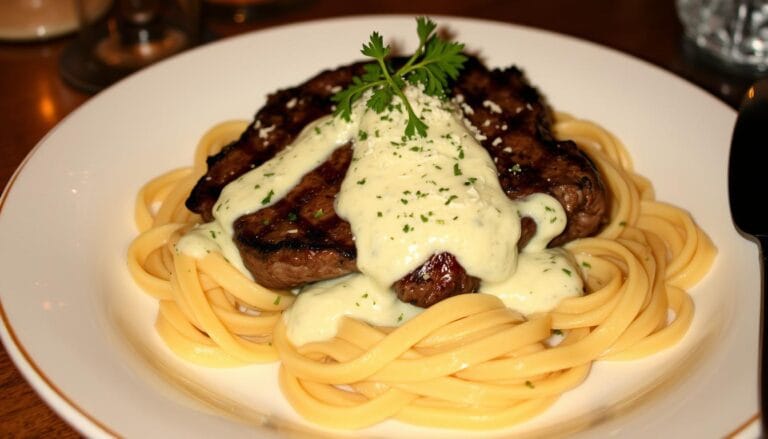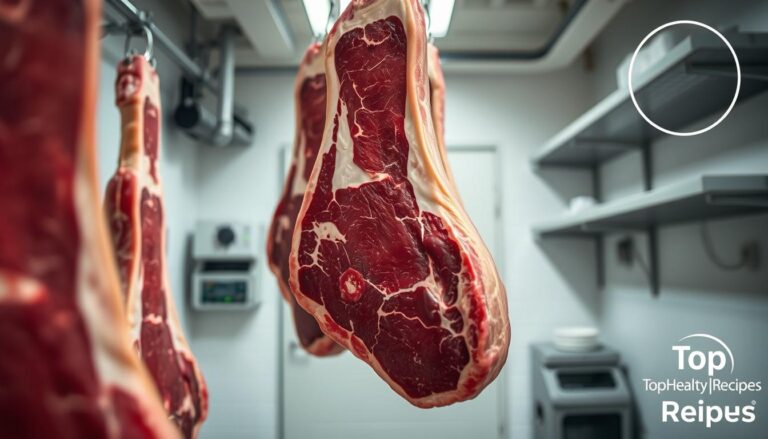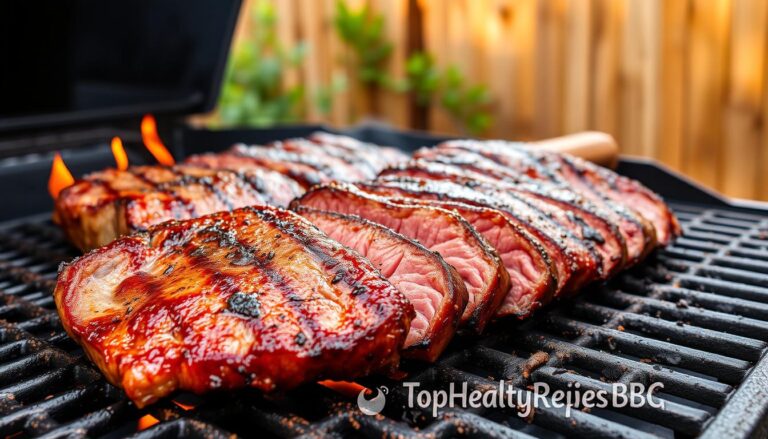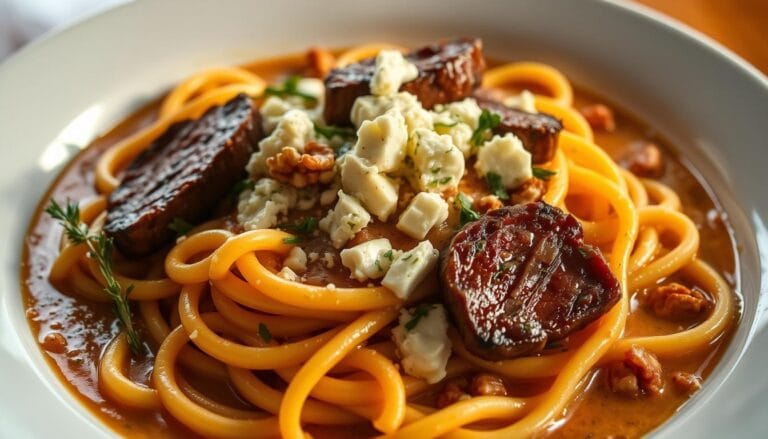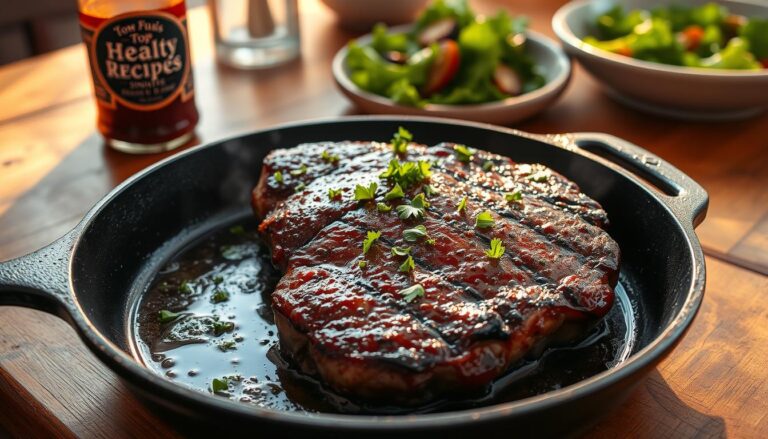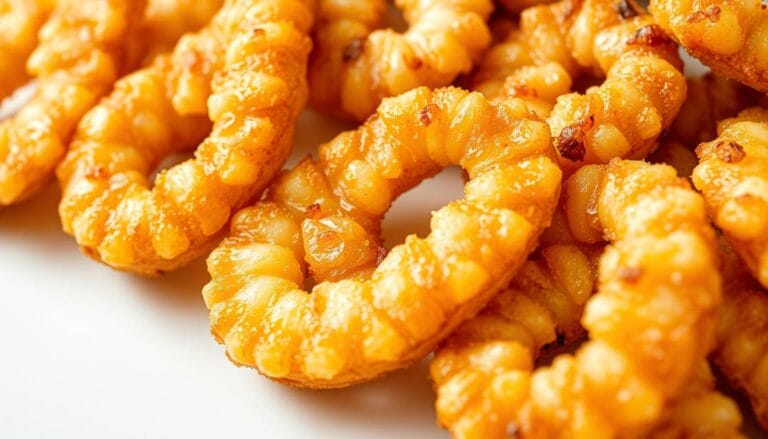How Big Is an 8 Ounce Steak? Portion Guide & Cooking Tips
Table of Contents
How Big Is an 8 Ounce Steak? Portion Guide & Cooking Tips
Imagine you’re at the grocery store, looking at different cuts of beef. You wonder if the package will be enough for you or if you’ll need more. Finding the right portion size can be tricky, but an 8-ounce steak is often just right. It’s big enough to enjoy but small enough to eat with other foods without feeling too full.
It’s easy to picture an 8-ounce steak. Think of it as the size of two decks of cards or a small smartphone. This size isn’t just about how much you eat. It’s about making meals that give you energy without being too heavy. Whether you’re grilling for a barbecue or prepping meals for the week, knowing the right portion size helps you cook better.
Key Takeaways
- An 8-ounce cut is roughly the size of two decks of cards or a smartphone.
- This portion balances protein needs with room for veggies and grains.
- Proper cooking techniques prevent dryness in smaller cuts.
- Visual comparisons simplify portioning without scales.
- Nutritionally, it aligns with many dietary guidelines for protein intake.
Choosing the right size isn’t just about numbers—it’s about making meals that keep you energized. Let’s look at how this versatile portion fits into your cooking and why it’s loved by both home chefs and nutritionists.
Understanding Steak Portions
Getting steak portions right makes your meal satisfying without going overboard. Whether you’re meal prepping or hosting a dinner, knowing what an 8-ounce steak looks like helps balance nutrition and enjoyment.
What Does an 8 Ounce Steak Look Like?
An 8 oz sirloin steak is roughly the size of two stacked decks of cards or a small smartphone. When raw, it’s about 1 inch thick and fits comfortably in your palm. Visual comparisons work best if you don’t have a kitchen scale handy.
For lean cuts like sirloin, the meat will appear slightly smaller after cooking due to moisture loss. Fatty cuts like ribeye shrink less but also reduce by 10-15% in size. This makes raw measurements more reliable for portion planning.
Importance of Portion Control
Keeping steak servings at 8 ounces helps manage calorie intake while delivering a protein boost. A typical 8 oz sirloin steak contains about 50 grams of protein – enough to support muscle growth without excessive saturated fat.
Portion control also prevents food waste and keeps meals cost-effective. Restaurants often serve 12-16 oz steaks, but home cooks can tailor sizes to their dietary needs. Use these strategies:
- Pre-cut steaks before freezing
- Share larger cuts with others
- Save leftovers for salads or sandwiches
Serving Size Comparisons
How does an 8 oz steak stack up against other proteins? Here’s a quick guide:
| Protein | Cooked Weight Equivalent | Calorie Match |
|---|---|---|
| Chicken Breast | 6 oz | 280-300 |
| Salmon Fillet | 5.5 oz | 300-320 |
| Pork Chop | 7 oz | 310-330 |
This comparison shows why steak feels more filling – it provides similar calories in a denser protein package. Pair it with vegetables to create balanced meals that keep you full longer.
Types of Steaks Available
Choosing the right steak can make your meal special. Each type has its own taste and texture. Let’s look at the most common types and how they match with different cooking styles and diets.
Popular Cuts of Steak
Ribeye is famous for its rich flavor and juicy texture. It’s great for those who love a fatty steak. Sirloin, like an 8 oz cut, is leaner but packs a lot of beefy taste. Filet mignon is tender but has less fat than the other two.
Nutritional Differences Between Cuts
Fat content changes a lot between cuts. An 8 oz sirloin steak has about 50g of protein and 15g of fat. Ribeye has nearly 30g of fat in the same size. Filet mignon has 20g of fat but a bit less protein.
| Cut | Calories (8 oz) | Protein | Fat |
|---|---|---|---|
| Ribeye | 670 | 56g | 30g |
| Sirloin | 450 | 50g | 15g |
| Filet Mignon | 520 | 48g | 20g |
Best Cooking Methods for Each Type
- Ribeye: Grill or pan-sear to melt the fat cap
- 8 oz sirloin: Marinate before broiling for maximum tenderness
- Filet mignon: Quick pan-searing preserves its delicate texture
For an 8 oz sirloin steak, medium-rare is best to keep it moist. Use a meat thermometer to check for 135°F inside. This cut is also good in stir-fries because of its balanced fat and lean meat.
Cooking an 8 Ounce Steak
Learning to cook a perfect 8-ounce steak involves three key areas: seasoning, technique, and precision. Whether you want a juicy medium-rare or a well-done steak, these tips will guide you. They help you avoid common mistakes and improve your steak cooking skills.
Preparing Your Steak: Seasoning Tips
Dry-brining is a great way to add flavor. Rub both sides of the steak with kosher salt at least 45 minutes before cooking. This method helps create a crispy crust while keeping the inside tender.
For even more flavor, sprinkle cracked black pepper or smoked paprika just before searing.
Recommended Cooking Techniques
Reverse searing is perfect for thicker cuts like ribeye. First, cook the steak in a 275°F oven until it’s 15°F below your desired temperature. Then, sear it in a hot cast iron skillet for 90 seconds to get that golden crust.
Other good methods include:
- Pan-searing for quick weeknight meals
- Grilling over charcoal for smoky flavor (great for shrimp and steak dishes)
- Sous vide for precise temperature control
Ideal Internal Temperatures
Use a digital meat thermometer to reach these temperatures:
| Doneness | Temperature (°F) |
|---|---|
| Rare | 120-125 |
| Medium Rare | 130-135 |
| Medium | 140-145 |
| Well Done | 160+ |
Remember, the steak’s temperature will increase by 5°F while it rests. Always let it rest for 5-7 minutes before slicing. This helps keep the juices inside.
Tools for Cooking Steak
Having the right tools makes cooking steak easy and precise. Whether you’re searing a ribeye or grilling a filet mignon, quality tools ensure consistent results. Let’s explore the essentials that belong in every steak enthusiast’s kitchen.
Essential Cooking Appliances
A cast-iron skillet is a must for achieving restaurant-quality crusts. Its even heat prevents cold spots that lead to uneven cooking. Outdoor grill lovers should opt for gas or charcoal models with adjustable temperature zones – Weber and Traeger are reliable brands.
For indoor cooking, consider a heavy-duty stainless steel pan or countertop grill like the George Foreman. These appliances handle high heat without warping, making them ideal for frequent use.
Recommended Utensils for a Perfect Steak
Sturdy tongs (avoid forks that pierce meat) give you control when flipping steaks. Pair them with a thin-edged metal spatula for delicate fish cuts or burgers. A sharp carving knife, like those from Victorinox, ensures clean slices without tearing the meat’s fibers.
- Heat-resistant gloves for handling hot pans
- Basting brush for applying butter or marinades
- Meat claws for pulling apart larger cuts
Using a Meat Thermometer
The ThermoPro TP-19 instant-read thermometer eliminates overcooking risks. Insert it sideways into the steak’s thickest part for accurate readings. For reverse-searing thick cuts, leave-in probes like the Meater+ track internal temps remotely via smartphone.
Remember: Rare steak reaches 125°F (51°C), while medium-rare stops at 135°F (57°C). Remove the meat 5°F below your target temperature – residual heat will finish the job during resting.
How to Shop for the Best Steak
Finding a great 8 oz sirloin steak takes more than just picking the first one. You need to check the marbling, compare how the cattle were raised, and look at USDA labels. This ensures you get the best taste and value for your meal.
Choosing Quality Meat at the Grocery Store
First, look at the steak’s marbling—the white streaks of fat. Marbling melts during cooking, making the meat juicy and flavorful. For an 8 oz sirloin, aim for moderate marbling without big fat pockets.
Also, check the steak’s color and texture. It should be bright red and firm. Avoid dull or slimy meat. Here’s a quick guide:
- Even marbling distribution
- Bright red color (no gray spots)
- Minimal liquid in the packaging
Grass-Fed vs. Grain-Fed Options
Grass-fed sirloin steaks come from pasture-raised cattle. They are leaner and have more omega-3s. Grain-fed beef, on the other hand, is fattier but milder in taste. Think about what you prefer:
| Grass-Fed | Grain-Fed | |
|---|---|---|
| Fat Content | Lower | Higher |
| Omega-3s | 2-4x more | Standard |
| Flavor | Earthy, robust | Buttery, mild |
Understanding USDA Grades
The USDA grades beef based on marbling and maturity. Here’s what’s important for an 8 oz sirloin steak:
| Grade | Marbling Level | Best For |
|---|---|---|
| Prime | Abundant | Grilling, searing |
| Choice | Moderate | Everyday meals |
| Select | Minimal | Marinating |
Prime-grade sirloin is very tender. Choice is a good balance of quality and price. Select is best if you plan to marinate the steak.
Marinating vs. Seasoning
Choosing between marinating and seasoning can make or break your steak’s flavor. Both methods enhance taste but work differently. Let’s explore how to use them effectively.
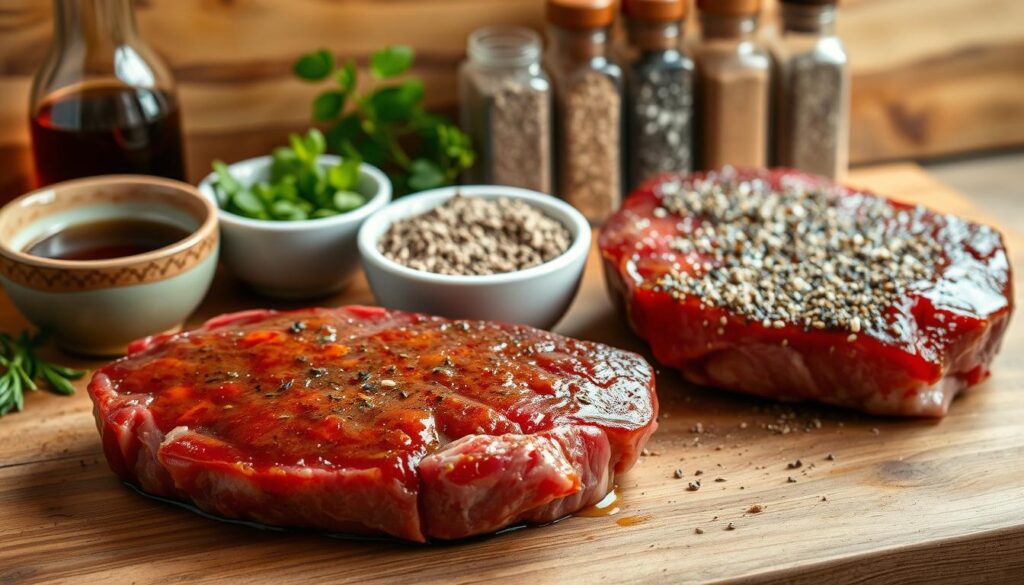
Benefits of Marinating
Marinating does more than add flavor—it tenderizes meat. Acidic marinades use vinegar or citrus juice to break down tough fibers. Enzymatic marinades, on the other hand, use pineapple or papaya to soften meat naturally.
| Type | Base Ingredient | Best For |
|---|---|---|
| Acidic | Lemon juice, vinegar | Tougher cuts (flank, skirt) |
| Enzymatic | Pineapple, yogurt | Quick tenderizing (30 mins max) |
Simple Marinade Recipes
Try these easy mixes for bold results:
- Classic Garlic-Herb: Olive oil, minced garlic, rosemary
- Asian-Inspired: Soy sauce, ginger, sesame oil
- Zesty Citrus: Orange juice, lime zest, chili flakes
Marinate steaks for 2-4 hours in the fridge. Avoid over-marinating delicate cuts like filet mignon—enzymes can turn them mushy.
Seasoning Tips for Maximum Flavor
When time is short, dry rubs deliver instant impact. Salt your steak 40 minutes before cooking to draw out moisture, then pat dry for better searing. Combine coarse pepper and smoked paprika for a smoky crust.
“A three-ingredient garlic-herb rub works wonders: mix 1 tbsp crushed garlic, 2 tsp dried thyme, and 1 tsp sea salt.”
Apply seasonings just before cooking for peak freshness. For thicker cuts, gently press spices into the meat’s surface.
Pairing Sides with Your Steak
A perfectly cooked 8-ounce steak needs sides that boost its taste without taking over. The best sides balance flavors, add texture, and make the meal feel complete. Whether it’s for a casual dinner or a special event, we’ve got you covered.
Classic Side Dishes to Complement Steak
Loaded baked potatoes are a hit: they’re creamy, cheesy, and full of flavor. They pair well with sirloin. For a lighter option, garlic-herb roasted asparagus is a great choice. It goes well with ribeye or New York strip.
Mashed potatoes with gravy or creamed spinach bring comfort. Crusty bread is perfect for soaking up juices. Charred corn on the cob with chili-lime seasoning adds a smoky touch.
Wine Pairings for an Elevated Experience
A bold Cabernet Sauvignon pairs well with fatty steaks like ribeye. A fruity Malbec is great for leaner cuts. For white wine fans, a buttery Chardonnay complements grilled meats nicely.
Sparkling wines or dry rosés are perfect with herb-rubbed steaks. Remember, serve reds slightly cooler than room temperature (60–65°F) to enhance their flavors.
Fresh Salads and Vegetables
Bright, crunchy sides like arugula salad with lemon vinaigrette and Parmesan add freshness. Roasted Brussels sprouts with balsamic glaze or honey-glazed carrots offer sweet-and-savory flavors.
For low-carb choices, try zucchini noodles with pesto or a kale Caesar salad. These options keep your meal light while adding vitamins and fiber.
Reheating and Leftovers
Leftover steak doesn’t have to be dry and chewy. With the right methods, you can keep it juicy and flavorful. Let’s look at how to reheat, reuse, and store your 8-ounce steak.
Best Practices for Reheating Steak
Sous vide is the top choice for reheating steak without drying it out. Put your leftover steak in a sealed bag and warm it in a water bath at 130°F for 30–45 minutes. Other good ways include:
- Oven method: Heat to 250°F. Place steak on a wire rack over a baking sheet for 10–15 minutes.
- Skillet revival: Sear chilled steak in butter for 60 seconds per side on medium-high heat.
“Always let reheated steak rest for 3–5 minutes before slicing to redistribute juices.”
Creative Ways to Use Leftover Steak
Make today’s meal out of yesterday’s dinner. Here are some tasty ideas:
| Recipe | Prep Time | Key Ingredients |
|---|---|---|
| Steak Tacos | 15 mins | Corn tortillas, lime crema, pickled onions |
| Philly Cheesesteak Omelet | 20 mins | Eggs, provolone, sautéed peppers |
| Steak Fried Rice | 25 mins | Day-old rice, soy sauce, scrambled egg |
Storage Tips for Freshness
Keep your steak fresh and tasty with these tips:
| Storage Method | Duration | Pro Tip |
|---|---|---|
| Refrigeration | 3–4 days | Wrap tightly in foil before placing in airtight container |
| Freezing | 2–3 months | Slice steak before freezing for easy portioning |
For the best results, cool steak to room temperature within two hours of cooking. Then, refrigerate it. Use freezer-safe bags with all air removed to avoid freezer burn.
Nutritional Information of an 8 Ounce Steak
An 8 oz sirloin steak is more than just tasty. It’s packed with nutrients that fuel your body. It’s great for tracking calories or boosting protein intake. Knowing its nutritional facts helps you enjoy it without guilt.
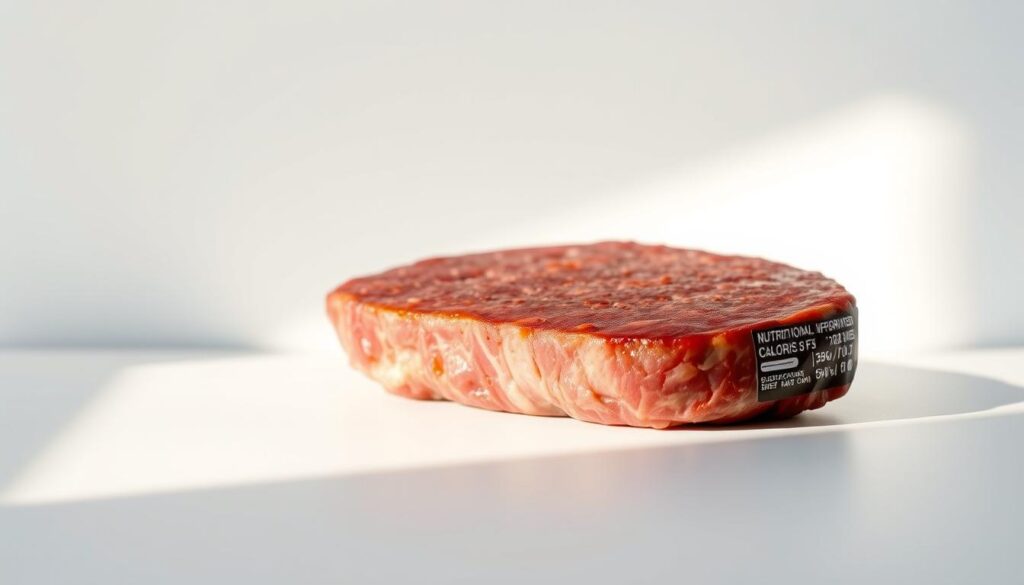
Caloric Content
A cooked 8 oz sirloin steak has about 330 calories. This makes it a good choice for meat lovers. In comparison, an 8 oz ribeye has 440 calories because it has more fat. Sirloin is leaner, making it a better option for a healthy meal.
Protein and Fat Breakdown
This steak has a lot of protein, about 56 grams. That’s enough for most adults in one meal. It also has 14 grams of fat, with only 5 grams being saturated. Here’s why it’s good:
- Protein helps repair muscles and keeps you full.
- Its low fat content is good for your heart.
“Sirloin’s lean protein-to-fat ratio makes it ideal for fitness-focused diets.”
Vitamins and Minerals in Steak
Steak is not just about macros. An 8 oz sirloin steak also has important nutrients. It has 30% of your daily iron for energy and 50% of your zinc for immune health. It’s also full of B vitamins, like B12, which is good for your nerves. Ribeye has more iron but a lot more saturated fat.
| Nutrient | 8 oz Sirloin | 8 oz Ribeye | Daily Value (%) |
|---|---|---|---|
| Calories | 330 | 440 | — |
| Protein | 56g | 48g | 112% |
| Total Fat | 14g | 34g | 22% |
| Iron | 5.4mg | 4.2mg | 30% |
Dietary Considerations
When planning meals around an 8 oz steak, it’s key to balance nutritional needs with personal health goals. Whether you’re fueling muscle growth or managing cholesterol levels, knowing how steak fits into your diet is important. It helps you make informed choices.
Steak and a High-Protein Diet
An 8 oz sirloin has about 50 grams of protein. This makes it great for active lifestyles. It supports muscle repair after workouts and keeps you full longer. Pair it with quinoa or lentils for a complete amino acid profile.
“Lean cuts like sirloin offer maximum protein with minimal waste fat – perfect for fitness-focused meal plans.”
Considerations for Heart Health
While steak provides iron and B vitamins, its saturated fat content needs moderation. Trim visible fat before cooking and limit red meat to 2-3 servings weekly. Opt for grass-fed options when possible – studies show they contain more heart-healthy omega-3s.
Balancing Your Plate with Vegetables
Complement your steak with fiber-rich sides to slow fat absorption. Try these combinations:
- Roasted Brussels sprouts with garlic
- Steamed broccoli sprinkled with sesame seeds
- Kale salad tossed in olive oil and lemon
These veggies add texture and nutrients while helping manage cholesterol levels. For best results, fill half your plate with colorful plants and reserve a quarter for your 8 oz portion.
Cooking for Special Occasions
Turning a steak dinner into a memorable event needs careful planning. Whether it’s for an anniversary, promotion, or holiday, these tips will make your meal unforgettable. It will impress both your guests’ eyes and taste buds.
Ideal Steaks for Celebration Dinners
Tomahawk steaks are perfect for making a big impression. Their long bone and thick cut serve 2-3 people. They also spark interesting conversations at the table. For smaller groups, consider:
- Dry-aged ribeyes with deep flavor
- Wagyu filet mignon for its unique texture
- Porterhouse cuts for a mix of two steaks
Presentation Tips for Serving
Enhance your plating with these top-notch techniques:
- Rest the steak on warm stone slabs or wooden boards
- Drizzle red wine reduction in artistic swirls
- Top with herb butter melting over the crust
Use roasted garlic mashed potatoes to prop up the steak. Add edible flowers like nasturtiums for a pop of color against the rich meat.
How to Make a Steak Dinner Memorable
Enhance your guests’ experience with these touches:
- Pair with a signature cocktail featuring smoked herbs
- Use charger plates under dinnerware for a formal look
- Present steak knives wrapped in linen ties
Tell the story of where the steak comes from. Whether it’s from Wyoming or Japan, sharing its origin makes the meal special.
Common Mistakes to Avoid
Mastering steak cooking means avoiding common mistakes. These errors can turn a juicy steak into a disappointing one. Let’s look at three key mistakes and how to avoid them.
Overcooking Your Steak
Carryover cooking increases your steak’s internal temperature after it’s removed from heat. Take your steak off the grill or pan 5°F before your desired doneness. For a medium-rare steak, aim for 125°F before removing it.
Use a digital meat thermometer to keep track. Thinner steaks cook faster. A 1-inch ribeye needs 4-5 minutes per side on high heat. Thicker steaks may need lower heat and longer cooking.
Skipping the Resting Period
Resting allows juices to spread evenly through the meat. Cutting too soon lets these juices spill out. For an 8-ounce steak:
- Rest 5 minutes for rare to medium-rare
- Rest 7-8 minutes for medium to well-done
Tent with foil to keep it warm without steaming the crust. This break also makes the steak easier to slice.
Choosing the Wrong Tools
Serrated knives tear meat, losing juices. Use a sharp chef’s knife or slicing knife instead. Other mistakes include:
- Non-stick pans (prevents proper searing)
- Flimsy tongs (can’t flip heavy steaks)
- Glass cutting boards (dull knives faster)
A cast-iron skillet and sturdy metal tongs are better. Always pat steaks dry before cooking. Moisture hinders a good sear.
Conclusion: Enjoying Your Steak
Learning how to cook steak right makes every meal better. Use top-quality ingredients and cook with care. This way, you get great taste and health benefits.
Prioritize Premium Cuts
Choose USDA Prime or Choice cuts from places like Omaha Steaks or Snake River Farms. These offer the best taste and texture. For a leaner option, try grass-fed steaks from ButcherBox, which are rich in omega-3s.
Smart Serving Strategies
Pair your 8-ounce steak with roasted Brussels sprouts or a quinoa salad for a balanced meal. Remove excess fat before cooking and use avocado oil for searing. A ThermoPro meat thermometer helps cook your steak just right.
Essential Final Tips
Let your steak rest for 5-7 minutes after cooking to keep it juicy. Use the pan drippings to make quick sauces with garlic and herbs. For steak tacos or Caesar salads, slice leftovers thinly against the grain.
Keep a temperature guide handy: 120°F for rare, 130°F for medium-rare, and 140°F for medium. Try dry brining with Maldon sea salt 24 hours before cooking for a better crust. Quality steaks deserve careful cooking – your taste buds will thank you.
FAQ
What does an 8-ounce steak look like?
How much protein is in an 8 oz sirloin steak?
What’s the best way to cook an 8-ounce steak?
How does grass-fed sirloin compare nutritionally?
Can I reheat steak without drying it out?
What sides pair well with an 8-ounce steak?
Is an 8 oz steak too big for a single serving?
What’s the biggest mistake when cooking steak?
How do I choose a quality 8 oz sirloin at the store?
Are marinades better than dry rubs for steak?
For more cooking tips, stay connected with us. We also recommend the cookbook Skinnytaste Simple: Easy, Healthy Recipes with 7 Ingredients or Fewer
For more Recipes about Steak ?
Did You try our recipe ?
There are no reviews yet. Be the first one to write one.
